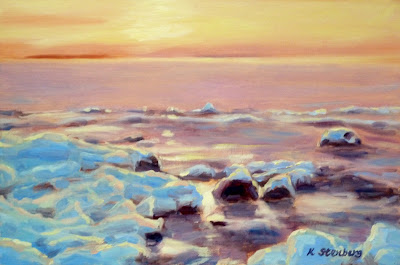 |
"Blue and Green Still Life"
sold |
 |
| Still Life setup with Rick Weaver |
 |
| Rick starts blocking in |
 |
| Rick's compact travel watercolor palette |
 |
| Rick's demo painting--loose and free! |
Last weekend I took a fabulous workshop--"Opaque Watercolors"--with Rick Weaver at the Art League School in Alexandria, VA. I was excited to see him in person, as he had the reputation of being brutally honest to students in what he says about their artwork. I have heard of students ending up in the bathroom to cry after his critique! Another reason for the anxiety was that, because of a low enrollment, there was an imminent danger of the workshop getting cancelled. Dang! I really wanted to learn how to use watercolors opaquely like oils for painting during vacations.
I am a dedicated plein-air painter and have dragged my painting gear around in my enthusiasm to all sorts of places, including national parks in the Southwest. But there is the bulk issue of the art gear necessary for outdoor painting in oil. An even bigger problem is traveling with oil paints and mediums. One has to take numerous precautions not to get your stuff thrown out of your luggage. These days, a traveling oil painter is treated worse than a terrorist with a bomb on the airplane!
I was tired of it all. I needed an intervention. I had to find out whether Rick's promise would deliver: the promise of maximizing the watercolor paints' potentials with one additional paint--a white gouache--to make them behave opaquely, but retaining transparency when appropriate. Fortunately, six additional students signed up for the workshop at the last moment. Thank goodness! And Rick did more than deliver. His reputation turned out to be false as well. He was a fun, gentle, encouraging, and phenomenal teacher!
On Saturday, we tackled still life to get the hang of the new medium. Even a veteran watercolorist such as myself found that adding a white gouache to watercolor paints transformed them into a totally different animal. Traditional transparent watercolors dry a little lighter; but opaque watercolor paints dry darker, just like acrylic paints. Strange. I also had to figure out the right water/paint ratio to make the paints flow. Tricky.
 |
| My still life value study (watercolor with white gouache; 9" x 9") |
In other words, it was hard! For a particularly struggling student, Rick did another quick demo of a value study with just one color of burnt umber. As we had only half an hour left by that time, several of us decided to do the same instead of starting a new still life as Rick made us switch to another setup. A slave driver! I didn't have the right color, so, instead, used Daniel Smith's "Moonglow". The above value study is pretty much a trasparent watercolor, with one exception. I restored lights with a white gouache here and there.
You see, that is precisely the point. In traditional watercolors, lights once lost are lost forever, just like Fitzwilliam Darcy's opinion once lost is lost forever in
Pride and Prejudice. In traditional watercolors, a white paint is death, anathema. One must preserve white and lights with life. But, honestly, who gives a darn! With a white added to your watercolor paints, you can go either way--darker or lighter. There is freedom. Hallelujah!
















































